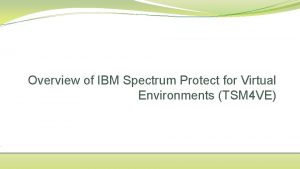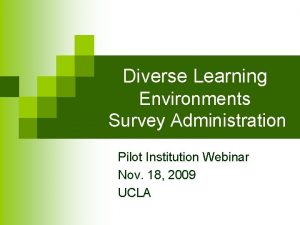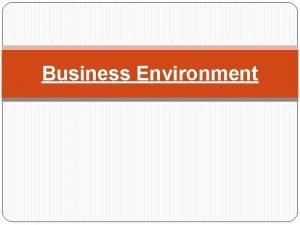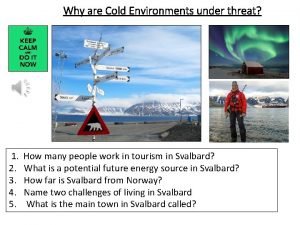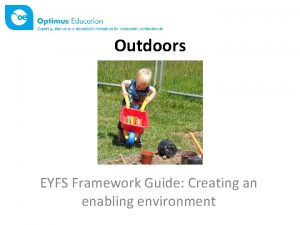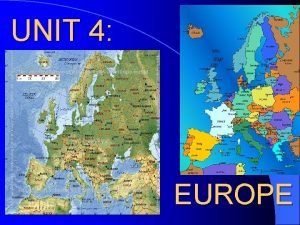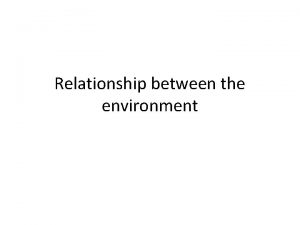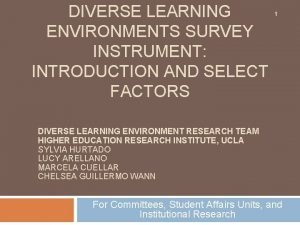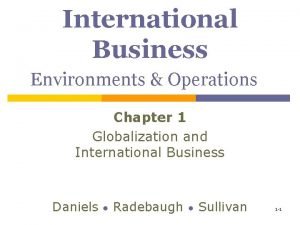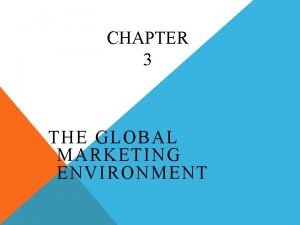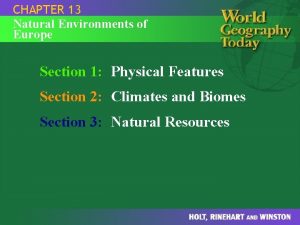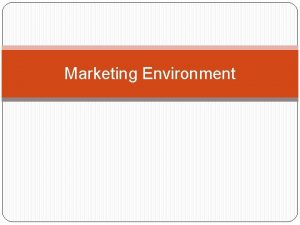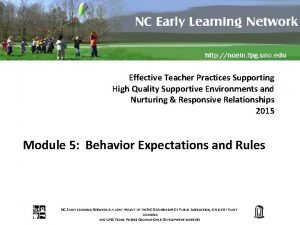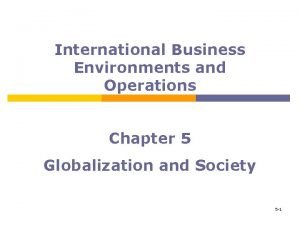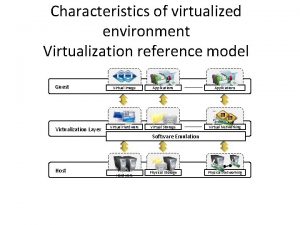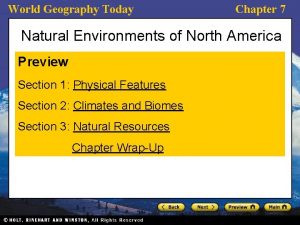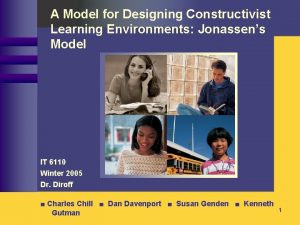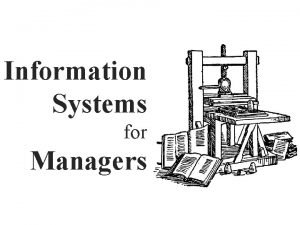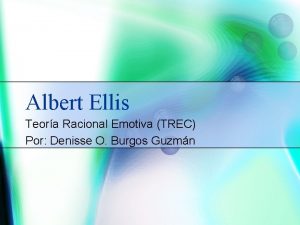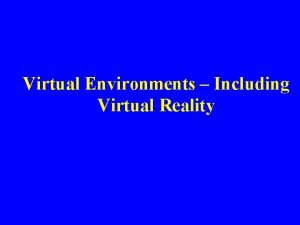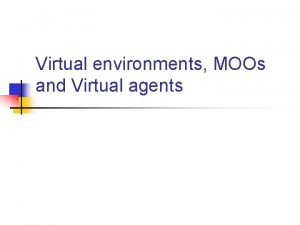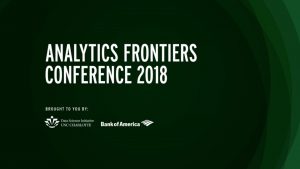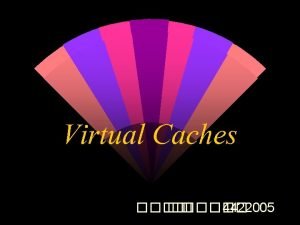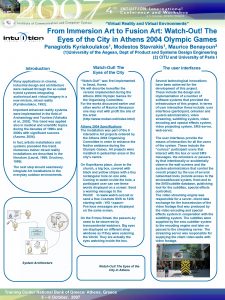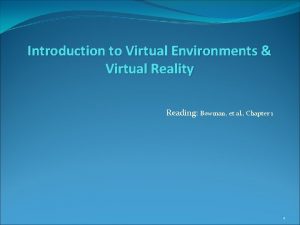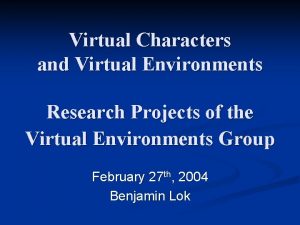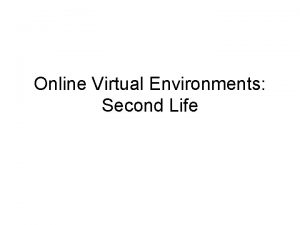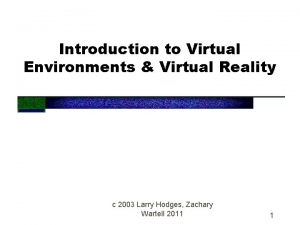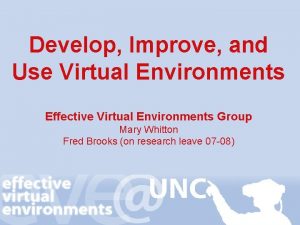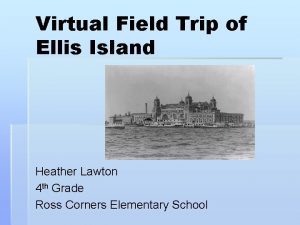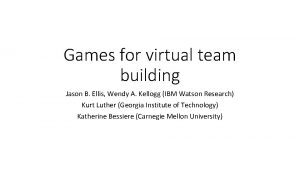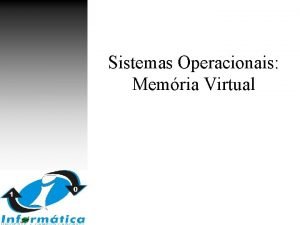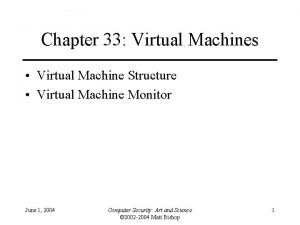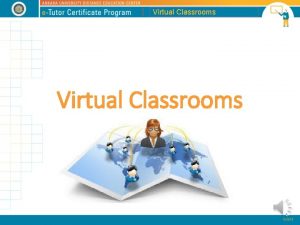Origins of Virtual Environments S R Ellis Origins

































- Slides: 33

Origins of Virtual Environments S. R. Ellis, Origins and Elements of Virtual Environments, in Virtual Environments and Advanced Interface Design, Barfield and Furness, Oxford University Press, 1995, pp. 14 -57 Summarized by Geb Thomas

Learning Objectives 4 1. Learn what VR is and how it works as a form of 4 4 communication. 2. Understand the concept of virtualization including the differences between virtual space, a virtual image and a virtual environment. 3. Learn about the history of virtual environments and the important pioneers and forces that shaped its creation. 4. Understand the variety and types of hardware used in VR. 5. Learn about the types of tradeoffs that VR technology requires, particularly cost versus performance, mass of gear to be worn, and resolution versus field of view.

Communications and Environments 4 VE’s are media, like books, movies or radio 4 Task of scientists is to make interaction with the media efficient and effortless -- reduce the adaptation period 4 VE extends the desktop metaphor to 3 D. 4 Historically this uses physical constraints from simulator and telerobotics fields

Components of VE 4 Content 4 Geometry 4 Dynamics

Content 4 Objects and actors described by characteristic vectors (a total description of each element) and position vectors (a subset of character vectors). 4 Self is a special actor representing point of view

Geometry 4 Dimensionality – Number of independent descriptive terms needd to specify the position vector 4 Metrics – Rules applied to the position vector to establish order 4 Extent – The range of possible values for the position vector

Dynamics 4 Rules of interaction of the content elements 4 Example, the differential equations of Newtonian dynamics.

Our Sense of Physical Reality 4 We construct reality from symbolic, geometric and dynamic information directly presented to our senses 4 Generally we see only a small part of the whole. 4 We rely on a priori knowledge 4 We are predisposed to certain arrangements of information -- we resonate with some more than others.

Virtualization 4 The process by which a human viewer interprets a patterned sensory impression to represent an extended object in a n environment other than that in which it physically exists. 4 Three levels: – Virtual space – Virtual image – Virtual Environment

Virtual Space 4 Perceived 3 D layout of objects in space when viewing a flat screen – perspective – shading – occlusion – texture gradients 4 This must be learned! False cues 4 Perceived size or scale is not inherent in media

Virtual Image 4 The perception of an object in depth with accommodative, vergence and (optionally) stereoscopic disparity cues are present. 4 Scale not arbitrary

Virtual Environment 4 Add observer-slaved motion parallax, depth of focus variation and wide field-of-view without visible restriction of the field of view 4 vergence 4 accommodative vergence - reflective change in vergence caused by focus adjust. 4 optokinetic reflex - eye tracking objects 4 vestibular-ocular reflex - eye tracking head

Virtual Environments (cont) 4 “Measurements of the degree to which a VE display convinces its users that they are present in the synthetic world can be made by measuring the degree to which these responses can be triggered in it. ” 4 Device calibration and timing are critical. The sensory systems can often adjust to systematic distortion, but not to time lags.

Viewpoints 4 Egocentric -- see the world from viewer’s point of view 4 Exocentric -- see the user acting in the world 4 Similar to inside-out and outside-in frames in aviation literature

Origins of VE 4 Human fascination with vicarious experience – cave art – Through the looking glass – Computer games – Neuromancer (Gibson) 4 Ivan Sutherland stereo display 4 Myron Krueger’s VIDEOPLACE 4 U. of Illinois’ CAVE

Vehicle Simulation 4 Much VE derived from aircraft and ship simulators 4 Development of special purpose machines: matrix multipliers -- graphic pipelines, graphic engines





Moving Simulators 4 Motion sickness 4 Subthreshold visual-vestibular mismatches to produce illusions of greater freedom of movement “washout” 4 Understand dynamic limits of visualvestibular miscorrelation

Cartography 4 Controlled information distortion – spherical projection – vertical scale exaggeration 4 VE’s can enhance presentation with graticules to help avoid effects of distortion. 4 Combine images to make virtual maps

Applications 4 Scientific and medical visualization – multiple time functions of force and torque on manipulator or limb joints – Volumetric medical data – Electronic dissection – Architectural Walk-throughs

Telerobotics 4 Predated many VR technology 4 Spurred position tracking technology – Polhemus system – accelerometers – optical tracking – acoustic systems – mechanical systems

Telerobotics II 4 Input devices – Isotonic (significant travel) – Isometric (sense force and torque) 4 Force feedback devices – high electro-mechanical bandwidth – Can create instabilities – Utah/MIT Hand

Photography, cinematography, viceo technology 4 The LEEP optical system, originally for stereo video used in VR stereo viewers 4 Sensorama, Morton Heilig (1955) 4 Interactive video map (MIT 1980)

Engineering Models 4 Tendency to overplay successes and suggest greater generality than exists 4 Most helmet-mounted displays make users legally blind 4 We need to understand characteristics of – – – human movement visual tracking vestibular responses grasp manual track time lags

VE: Performance and Trade-Offs 4 Performance Advances 4 Stereoscopic visual strain 4 Resolution/field-of-view tradeoff 4 Appropriate application areas: – multiple, simultaneous, coordinated, real-time foci of control – Manipulation of objects in complex visual environments and require frequent, concurrent changes in viewing position



Learning Objectives 4 1. Learn what VR is and how it works as a form of 4 4 communication. 2. Understand the concept of virtualization including the differences between virtual space, a virtual image and a virtual environment. 3. Learn about the history of virtual environments and the important pioneers and forces that shaped its creation. 4. Understand the variety and types of hardware used in VR. 5. Learn about the types of tradeoffs that VR technology requires, particularly cost versus performance, mass of gear to be worn, and resolution versus field of view.

For Friday 4 Read the NRC Report, especially 13 -24 and 35 -66. Skim the rest 4 Personally, I think the recommendations are very interesting, because they reveal how a panel of scientists think of what research is important. Depending on where you are in your career, however this may not be so key. 4 Start drafting your essay. I want to see complete, supported ideas, not stream-of-consciousness!

 Ibm spectrum protect for virtual environments
Ibm spectrum protect for virtual environments Has virtual functions and accessible non-virtual destructor
Has virtual functions and accessible non-virtual destructor Diverse learning environments survey
Diverse learning environments survey Meaning of business environment
Meaning of business environment Why are cold environments under threat
Why are cold environments under threat Psychologically informed environments
Psychologically informed environments International business environments and operations
International business environments and operations Different environments
Different environments Online search agents and unknown environments
Online search agents and unknown environments Enabling environments eyfs
Enabling environments eyfs Chapter 13 natural environments of europe
Chapter 13 natural environments of europe Interrelationship between macro and market environment
Interrelationship between macro and market environment Creating supportive environments smoking
Creating supportive environments smoking Diverse learning environments survey
Diverse learning environments survey International business: environments and operations
International business: environments and operations Marketing environments
Marketing environments Chapter 13 natural environments of europe
Chapter 13 natural environments of europe International business environments and operations
International business environments and operations Peng cui tsinghua
Peng cui tsinghua Main actors and forces in a modern marketing system
Main actors and forces in a modern marketing system High quality supportive environments
High quality supportive environments International business environments and operations
International business environments and operations Characteristics of virtualized environment
Characteristics of virtualized environment World geography
World geography Jonassen constructivist learning environment
Jonassen constructivist learning environment Exercise in hot and cold environments
Exercise in hot and cold environments Psychologically informed environments
Psychologically informed environments Information-intensive operating environments
Information-intensive operating environments Example of external environment in school
Example of external environment in school John ellis physics
John ellis physics Ellis island and angel island venn diagram
Ellis island and angel island venn diagram History of rebt
History of rebt Edad de albert ellis
Edad de albert ellis Ellis island inspection card
Ellis island inspection card
